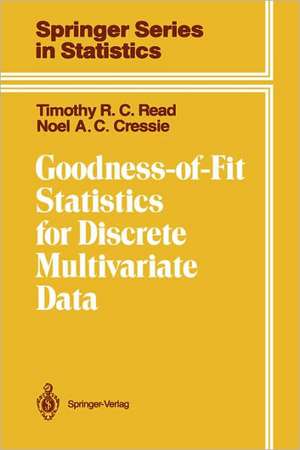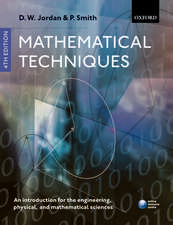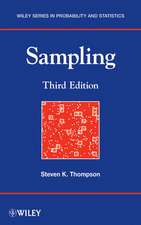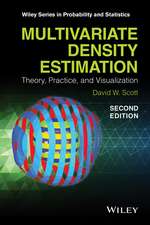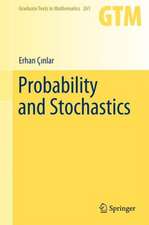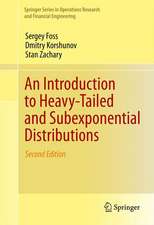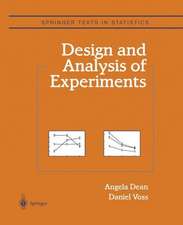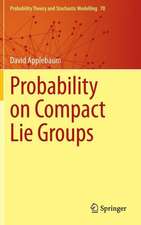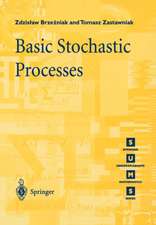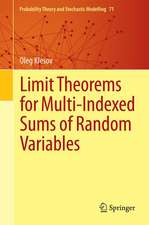Goodness-of-Fit Statistics for Discrete Multivariate Data: Springer Series in Statistics
Autor Timothy R.C. Read, Noel A.C. Cressieen Limba Engleză Hardback – aug 1988
| Toate formatele și edițiile | Preț | Express |
|---|---|---|
| Paperback (1) | 384.31 lei 43-57 zile | |
| Springer – 14 oct 2011 | 384.31 lei 43-57 zile | |
| Hardback (1) | 390.84 lei 43-57 zile | |
| Springer – aug 1988 | 390.84 lei 43-57 zile |
Din seria Springer Series in Statistics
- 14%
 Preț: 679.60 lei
Preț: 679.60 lei - 20%
 Preț: 630.98 lei
Preț: 630.98 lei - 20%
 Preț: 816.45 lei
Preț: 816.45 lei - 20%
 Preț: 1000.85 lei
Preț: 1000.85 lei -
 Preț: 390.84 lei
Preț: 390.84 lei - 20%
 Preț: 697.14 lei
Preț: 697.14 lei - 20%
 Preț: 445.20 lei
Preț: 445.20 lei - 20%
 Preț: 884.71 lei
Preț: 884.71 lei - 18%
 Preț: 1237.14 lei
Preț: 1237.14 lei - 18%
 Preț: 961.82 lei
Preț: 961.82 lei - 18%
 Preț: 956.50 lei
Preț: 956.50 lei - 18%
 Preț: 794.25 lei
Preț: 794.25 lei - 15%
 Preț: 648.05 lei
Preț: 648.05 lei - 18%
 Preț: 1217.10 lei
Preț: 1217.10 lei - 15%
 Preț: 646.11 lei
Preț: 646.11 lei - 15%
 Preț: 647.08 lei
Preț: 647.08 lei - 15%
 Preț: 646.11 lei
Preț: 646.11 lei - 18%
 Preț: 1329.76 lei
Preț: 1329.76 lei - 15%
 Preț: 652.81 lei
Preț: 652.81 lei - 18%
 Preț: 1114.52 lei
Preț: 1114.52 lei - 18%
 Preț: 952.40 lei
Preț: 952.40 lei - 18%
 Preț: 1333.42 lei
Preț: 1333.42 lei - 18%
 Preț: 1561.68 lei
Preț: 1561.68 lei - 18%
 Preț: 1231.47 lei
Preț: 1231.47 lei - 15%
 Preț: 513.64 lei
Preț: 513.64 lei - 18%
 Preț: 893.71 lei
Preț: 893.71 lei - 15%
 Preț: 649.87 lei
Preț: 649.87 lei - 18%
 Preț: 1007.65 lei
Preț: 1007.65 lei - 18%
 Preț: 1111.67 lei
Preț: 1111.67 lei - 18%
 Preț: 1223.70 lei
Preț: 1223.70 lei - 18%
 Preț: 892.74 lei
Preț: 892.74 lei - 18%
 Preț: 913.26 lei
Preț: 913.26 lei - 18%
 Preț: 943.88 lei
Preț: 943.88 lei -
 Preț: 391.61 lei
Preț: 391.61 lei -
 Preț: 391.22 lei
Preț: 391.22 lei - 18%
 Preț: 1331.18 lei
Preț: 1331.18 lei - 18%
 Preț: 888.45 lei
Preț: 888.45 lei - 18%
 Preț: 960.61 lei
Preț: 960.61 lei - 18%
 Preț: 1245.34 lei
Preț: 1245.34 lei - 18%
 Preț: 964.54 lei
Preț: 964.54 lei - 15%
 Preț: 643.16 lei
Preț: 643.16 lei - 18%
 Preț: 1723.76 lei
Preț: 1723.76 lei - 15%
 Preț: 643.84 lei
Preț: 643.84 lei - 15%
 Preț: 586.37 lei
Preț: 586.37 lei - 18%
 Preț: 999.59 lei
Preț: 999.59 lei - 15%
 Preț: 643.34 lei
Preț: 643.34 lei - 18%
 Preț: 806.40 lei
Preț: 806.40 lei - 18%
 Preț: 727.66 lei
Preț: 727.66 lei
Preț: 390.84 lei
Nou
Puncte Express: 586
Preț estimativ în valută:
74.81€ • 81.29$ • 62.88£
74.81€ • 81.29$ • 62.88£
Carte tipărită la comandă
Livrare economică 21 aprilie-05 mai
Preluare comenzi: 021 569.72.76
Specificații
ISBN-13: 9780387966823
ISBN-10: 038796682X
Pagini: 212
Ilustrații: XII, 212 p.
Dimensiuni: 155 x 235 x 15 mm
Greutate: 0.48 kg
Ediția:1988
Editura: Springer
Colecția Springer
Seria Springer Series in Statistics
Locul publicării:New York, NY, United States
ISBN-10: 038796682X
Pagini: 212
Ilustrații: XII, 212 p.
Dimensiuni: 155 x 235 x 15 mm
Greutate: 0.48 kg
Ediția:1988
Editura: Springer
Colecția Springer
Seria Springer Series in Statistics
Locul publicării:New York, NY, United States
Public țintă
GraduateCuprins
1 Introduction to the Power-Divergence Statistic.- 1.1 A Unified Approach to Model Testing.- 1.2 The Power-Divergence Statistic.- 1.3 Outline of the Chapters.- 2 Defining and Testing Models: Concepts and Examples.- 2.1 Modeling Discrete Multivariate Data.- 2.2 Testing the Fit of a Model.- 2.3 An Example: Time Passage and Memory Recall.- 2.4 Applying the Power-Divergence Statistic.- 2.5 Power-Divergence Measures in Visual Perception.- 3 Modeling Cross-Classified Categorical Data.- 3.1 Association Models and Contingency Tables.- 3.2 Two-Dimensional Tables: Independence and Homogeneity.- 3.3 Loglinear Models for Two and Three Dimensions.- 3.4 Parameter Estimation Methods: Minimum Distance Estimation.- 3.5 Model Generation: A Characterization of the Loglinear, Linear, and Other Models through Minimum Distance Estimation.- 3.6 Model Selection and Testing Strategy for Loglinear Models.- 4 Testing the Models: Large-Sample Results.- 4.1 Significance Levels under the Classical (Fixed-Cells) Assumptions.- 4.2 Efficiency under the Classical (Fixed-Cells) Assumptions.- 4.3 Significance Levels and Efficiency under Sparseness Assumptions.- 4.4 A Summary Comparison of the Power-Divergence Family Members.- 4.5 Which Test Statistic?.- 5 Improving the Accuracy of Tests with Small Sample Size.- 5.1 Improved Accuracy through More Accurate Moments.- 5.2 A Second-Order Correction Term Applied Directly to the Asymptotic Distribution.- 5.3 Four Approximations to the Exact Significance Level: How Do They Compare?.- 5.4 Exact Power Comparisons.- 5.5 Which Test Statistic?.- 6 Comparing the Sensitivity of the Test Statistics.- 6.1 Relative Deviations between Observed and Expected Cell Frequencies.- 6.2 Minimum Magnitude of the Power-Divergence Test Statistic.- 6.3 Further Insights into the Accuracy of Large-Sample Approximations.- 6.4 Three Illustrations.- 6.5 Transforming for Closer Asymptotic Approximations in Contingency Tables with Some Small Expected Cell Frequencies.- 6.6 A Geometric Interpretation of the Power-Divergence Statistic.- 6.7 Which Test Statistic?.- 7 Links with Other Test Statistics and Measures of Divergence.- 7.1 Test Statistics Based on Quantiles and Spacings.- 7.2 A Continuous Analogue to the Discrete Test Statistic.- 7.3 Comparisons of Discrete and Continuous Test Statistics.- 7.4 Diversity and Divergence Measures from Information Theory.- 8 Future Directions.- 8.1 Hypothesis Testing and Parameter Estimation under Sparseness Assumptions.- 8.2 The Parameter ? as a Transformation.- 8.3 A Generalization of Akaike’s Information Criterion.- 8.4 The Power-Divergence Statistic as a Measure of Loss and a Criterion for General Parameter Estimation.- 8.5 Generalizing the Multinomial Distribution.- Historical Perspective: Pearson’s X2 and the Loglikelihood Ratio Statistic G2.- 1. Small-Sample Comparisons of X2 and G2 under the Classical (Fixed-Cells) Assumptions.- 2. Comparing X2 and G2 under Sparseness Assumptions.- 3. Efficiency Comparisons.- 4. Modified Assumptions and Their Impact.- Appendix: Proofs of Important Results.- A1. Some Results on Rao Second-Order Efficiency and Hodges-Lehmann Deficiency (Section 3.4).- A2. Characterization of the Generalized Minimum Power-Divergence Estimate (Section 3.5).- A3. Characterization of the Lancaster-Additive Model (Section 3.5).- A4. Proof of Results (i), (ii), and (iii) (Section 4.1).- A5. Statement of Birch’s Regularity Conditions and Proof that the Minimum Power-Divergence Estimator Is BAN (Section 4.1).- A6. Proof of Results (i*), (ii*), and (iii*) (Section 4.1).- A7. The Power-DivergenceGeneralization of the Chernoff-Lehmann Statistic: An Outline (Section 4.1).- A8. Derivation of the Asymptotic Noncentral Chi-Squared Distribution for the Power-Divergence Statistic under Local Alternative Models (Section 4.2).- A9. Derivation of the Mean and Variance of the Power-Divergence Statistic for ? > -1 under a Nonlocal Alternative Model (Section 4.2).- A10. Proof of the Asymptotic Normality of the Power-Divergence Statistic under Sparseness Assumptions (Section 4.3).- A12. Derivation of the Second-Order Terms for the Distribution Function of the Power-Divergence Statistic under the Classical (Fixed-Cells) Assumptions (Section 5.2).- A13. Derivation of the Minimum Asymptotic Value of the Power-Divergence Statistic (Section 6.2).- A14. Limiting Form of the Power-Divergence Statistic as the Parameter ? ? ± ? (Section 6.2).- Author Index.
